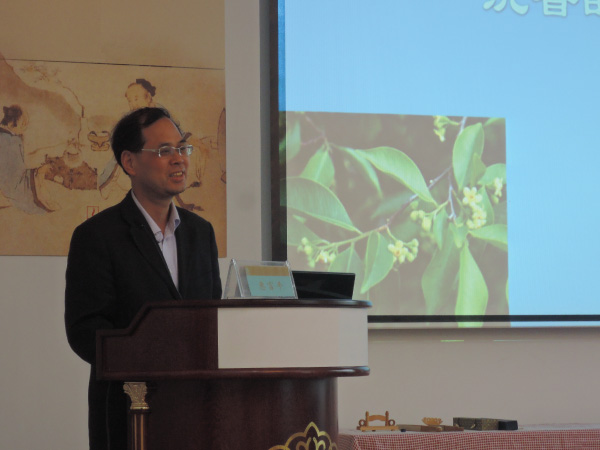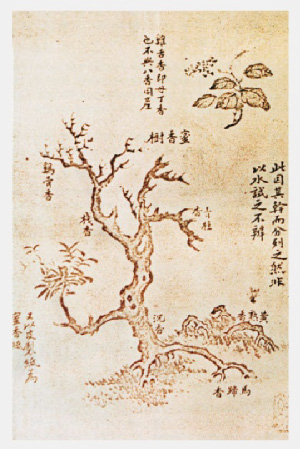NEWS & EVENTS > NEWS
"A nation's culture resides in the hearts and in the soul of its people"
-Mahatma Ghandi
A Botanic Perspective on Agarwood
6 May 2015
Professor Hui Fu Ping from the College of Humanities and Sociences at Nanjing Agricultural University, presented at the Incense of Culture: 2015 Chinese Incense Conference, May 2, 2015.

6 May 2015
Professor Hui Fu Ping from the College of Humanities and Sociences at Nanjing Agricultural University, presented at the Incense of Culture: 2015 Chinese Incense Conference, May 2, 2015.

Agarwood is the inescapable axis around which the world of Chinese incense seems to revolve today. This resinous heartwood, valued for its distinctive fragrance, has a current global market estimated to be in the range of US $6-8 billion1. Entire institutes and museums centering on agarwood have sprung up to cater for the demand of this precious commodity. While it could be argued that the intense focus on agarwood has had a reductive effect on the public's understanding of Chinese incense culture, its behemoth presence necessitates more informed knowledge about its use and production. On the second day of Culture of Incense: 2015 Chinese Incense Conference, held 1-2 May 2015 in Nanjing, Professor Hui Fuping from Nanjing Agricultural University and author of the book Chinese Traditional Culture of Agroecology, took to the podium to give a presentation on agarwood that provides a refreshing perspective on agarwood from a botanical and agroecological point of view.
Professor Hui began his presentation by quoting the Chinese poem "Ten characters of agarwood" written by Huang Tingjian, the famous poet from the Northern Song dynasty, in order to give a clear introduction of agarwood to the audiences.

Illustration from Nanjing Caomu Zhuang 《南方草木状》, showing the different parts of the Aquilaria plant that agarwood comes from. Only heartwood from the trunk of the tree can probably be called chen xiang (沉香). Professor Hui's presentation moved from broad to in-depth, first talking about the scientific naming, ecology, and plant physiology, and then towards the end, discussing the sustainability of agarwood, including cultivation of artificial agarwood. The presentation highlighted the improvements in producing high quality agarwood in order to fulfill the tremendous demands for this commodity in China.
A common misconception about agarwood
There is a saying in China that "one tael of agarwood equals to a tael of gold", indicative of the precious value of agarwood as a raw materials in a lot of places. People used it as incense to burn, or to season the wine or directly carved it as decorations. In general, Buddhists and the rich would have been the portion of society that had more opportunities to come into contact with agarwood, with agarwood often being involved in Buddhists ceremonies, and the rich having the financial capability to collect agarwood. The more they came in touch with this luxurious material, the more the learned to differentiate the kinds, quality, and grades of agarwood.
Professor Hui began his presentation by quoting the Chinese poem "Ten characters of agarwood" written by Huang Tingjian, the famous poet from the Northern Song dynasty, in order to give a clear introduction of agarwood to the audiences.

Illustration from Nanjing Caomu Zhuang 《南方草木状》, showing the different parts of the Aquilaria plant that agarwood comes from. Only heartwood from the trunk of the tree can probably be called chen xiang (沉香).
A common misconception about agarwood
There is a saying in China that "one tael of agarwood equals to a tael of gold", indicative of the precious value of agarwood as a raw materials in a lot of places. People used it as incense to burn, or to season the wine or directly carved it as decorations. In general, Buddhists and the rich would have been the portion of society that had more opportunities to come into contact with agarwood, with agarwood often being involved in Buddhists ceremonies, and the rich having the financial capability to collect agarwood. The more they came in touch with this luxurious material, the more the learned to differentiate the kinds, quality, and grades of agarwood.
Page 1 | 2
Related Links:
ENGLISH TRANSLATION:
"Tang Dynasty Incense archaeological discoveries" transcript
Xin Ge
PRESENTATION SLIDES:
"Tang Dynasty Incense archaeological discovieries"
Xin Ge
ENGLISH TRANSLATION:
"Han Dynasty Insense archaeological discoveries " transcript
Liu Hai Wang
PRESENTATION TRANSCRIPT:
Han Dynasty Incense tradition
5 May 2015
PHOTOS:
Incense Conference 2015
VIDEOS:
Incense Conference 2015
"Tang Dynasty Incense archaeological discoveries" transcript
Xin Ge
PRESENTATION SLIDES:
"Tang Dynasty Incense archaeological discovieries"
Xin Ge
ENGLISH TRANSLATION:
"Han Dynasty Insense archaeological discoveries " transcript
Liu Hai Wang
PRESENTATION TRANSCRIPT:
Han Dynasty Incense tradition
5 May 2015
PHOTOS:
Incense Conference 2015
VIDEOS:
Incense Conference 2015
